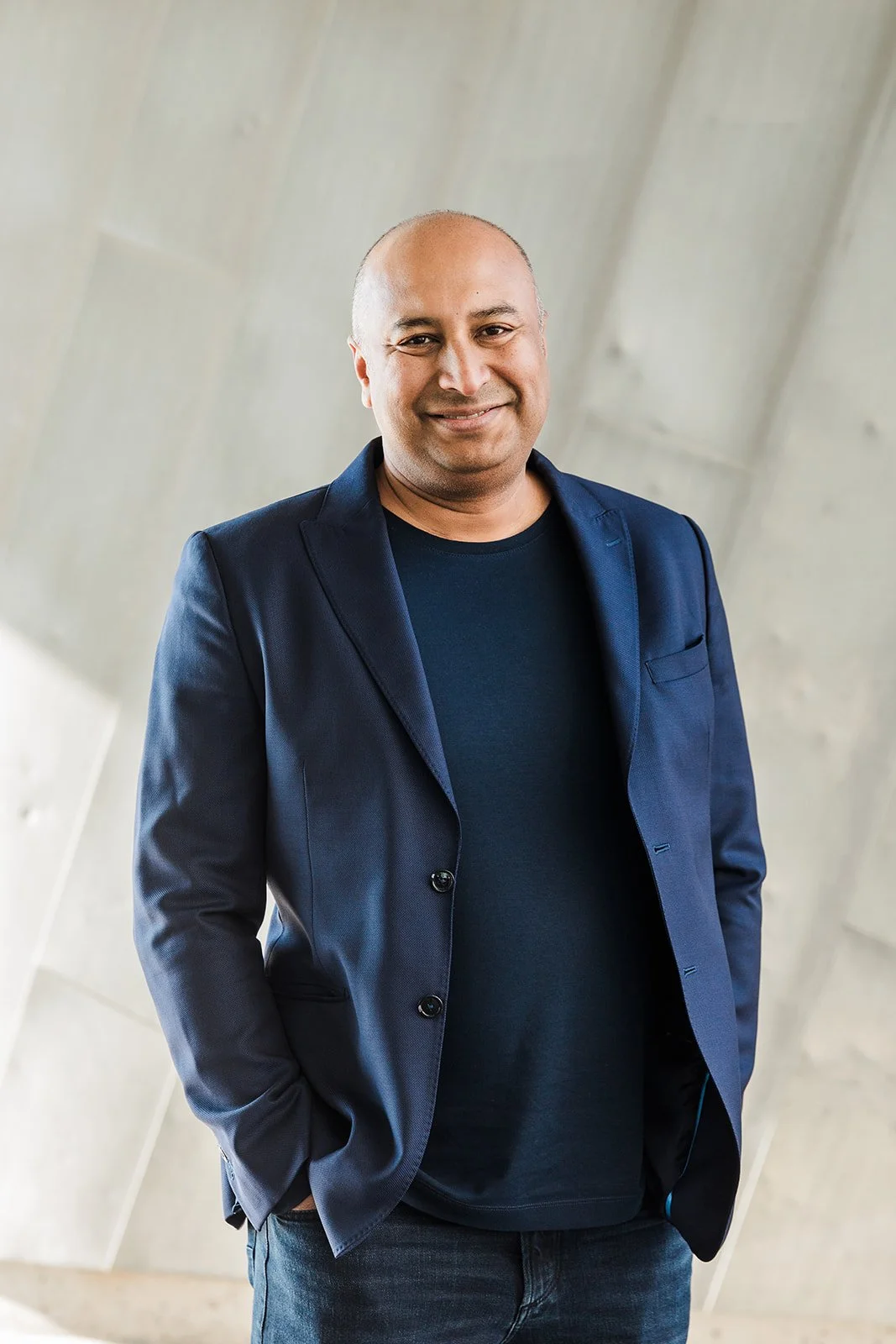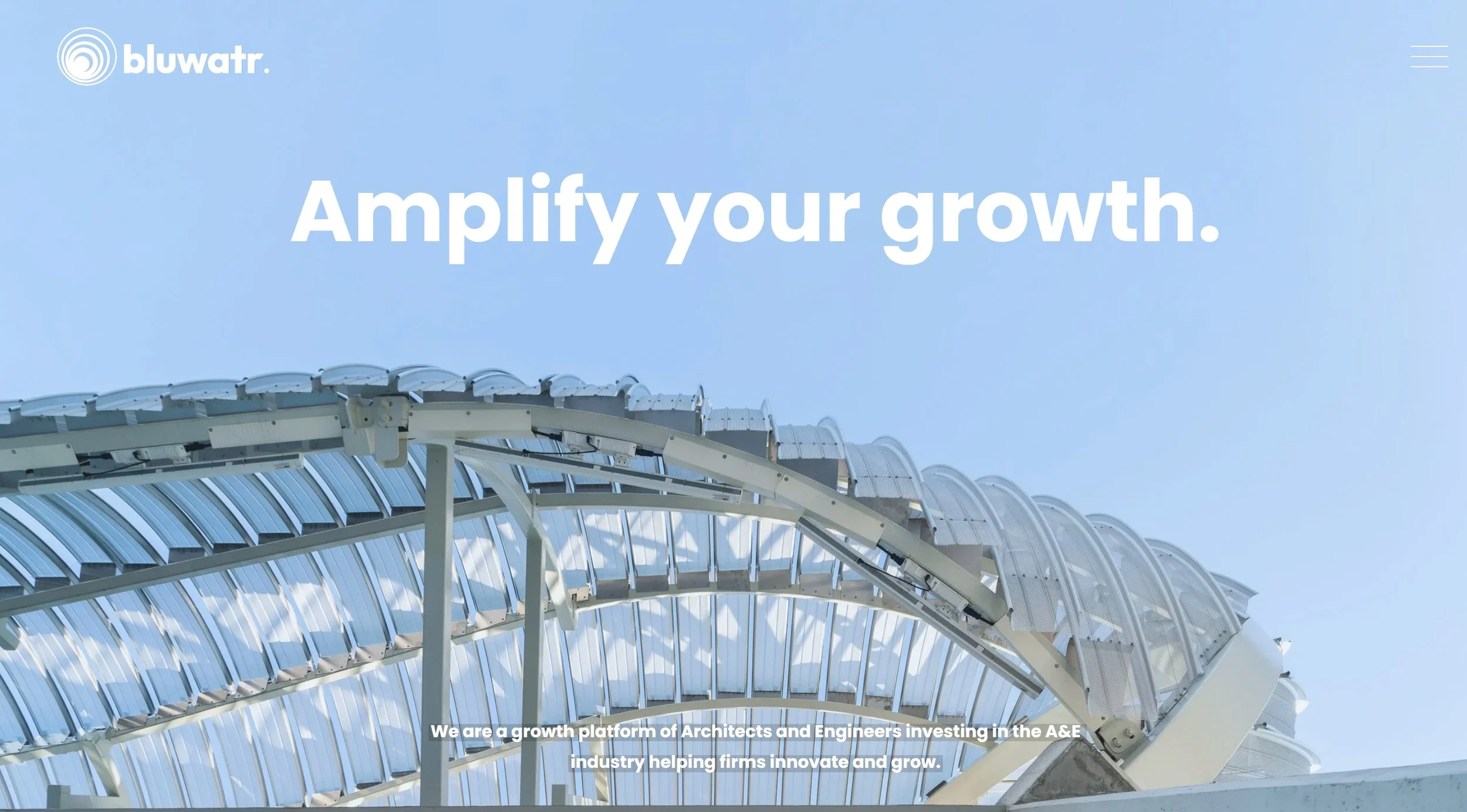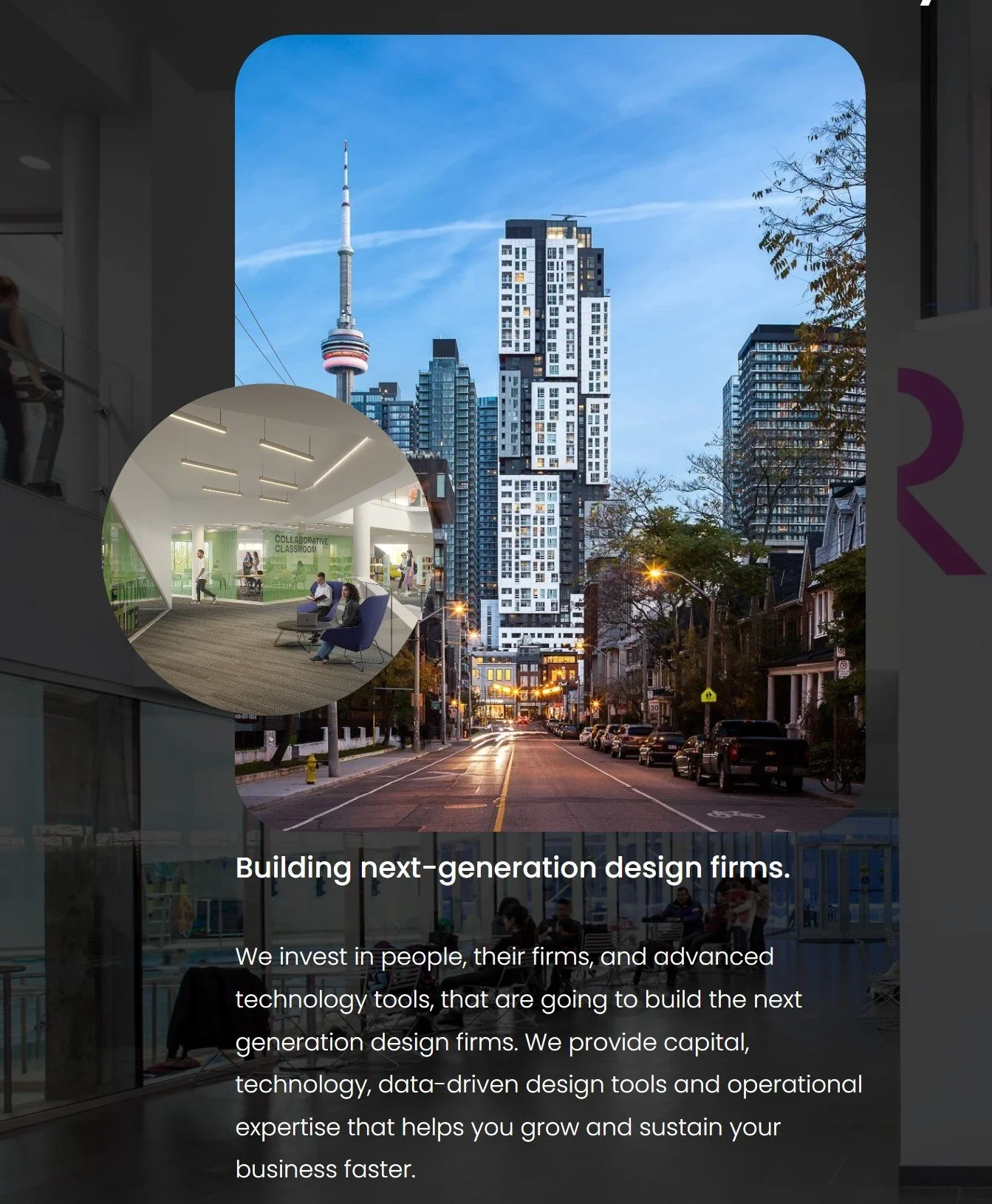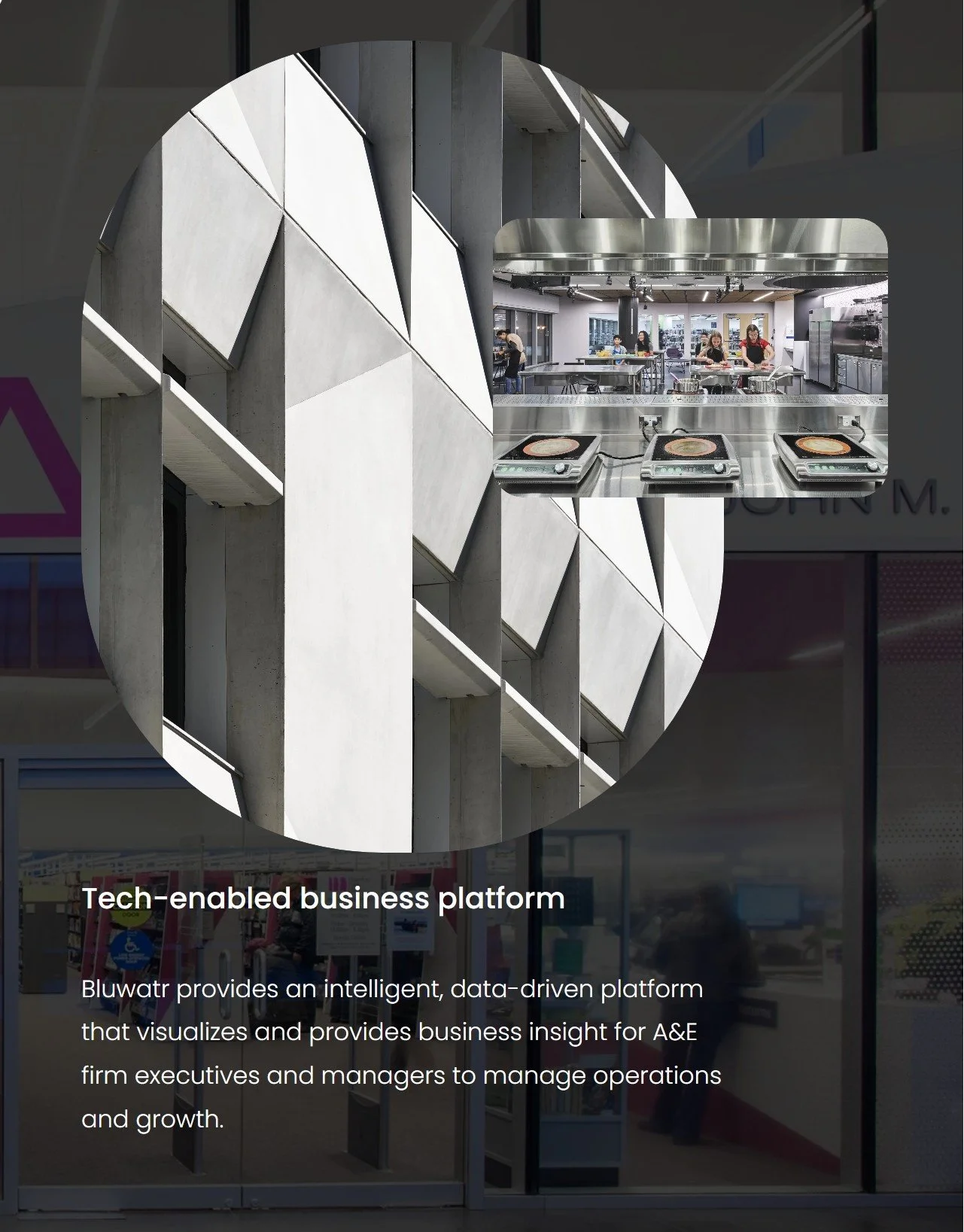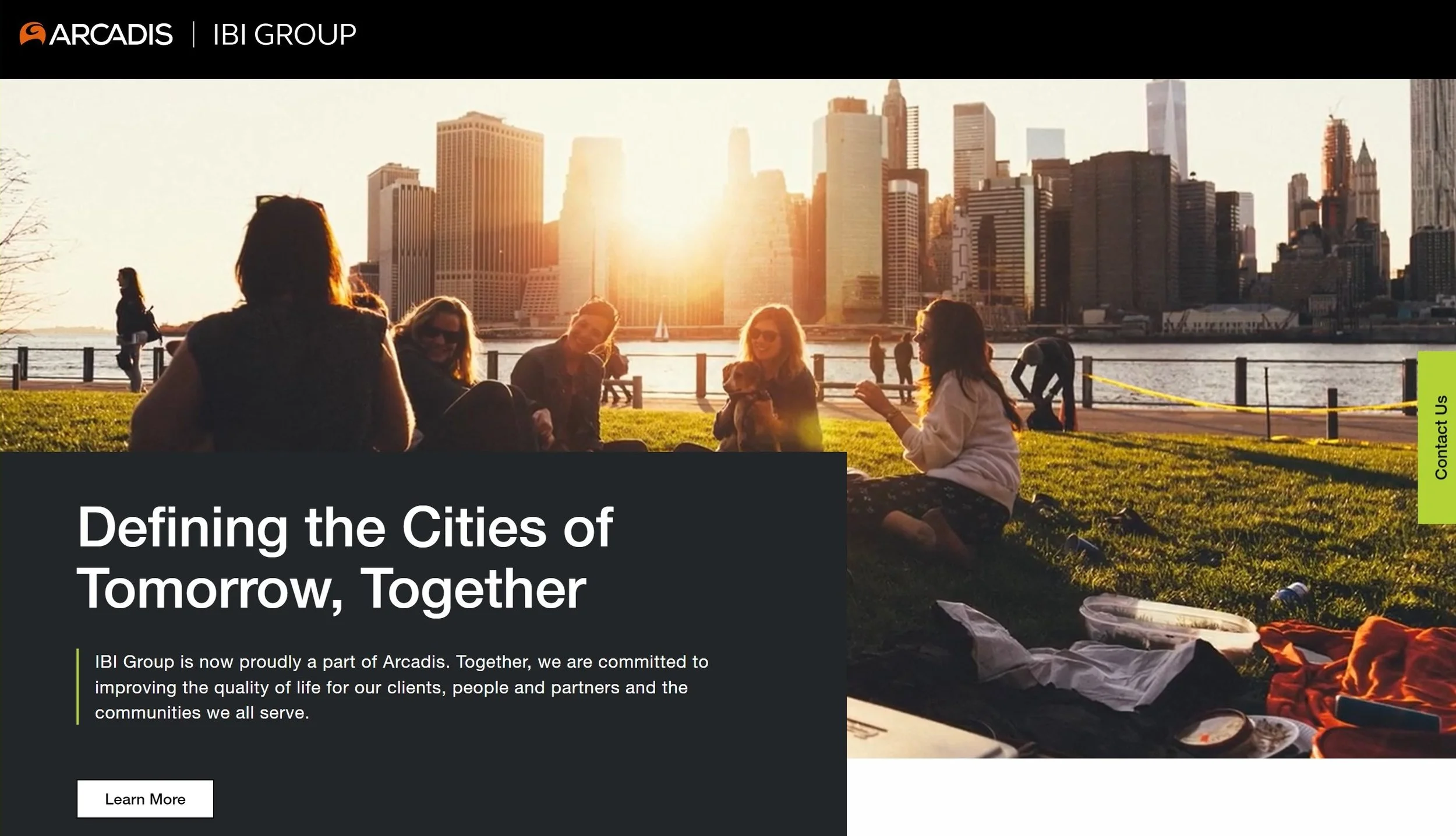A New bluprnt for A&E Firm Success
A CONVERSATION WITH ARI BOSE ON BUILDING SCALABLE A&E FIRMS IN A DISRUPTED INDUSTRY
I relaunched Oomph after seeing the AEC industry start down the same disruptive path that had reshaped marketing 15 years earlier. By 2017, it was clear that digital tools—backed by serious venture capital—were about to transform how AEC firms worked and competed.
While researching how firms were adapting, I revisited IBI and was struck by their evolution. Their transportation tech products helped them to compete on large, complex projects, led by bigger firms, and their “Defining the Cities of Tomorrow” brand brought everything—services, sectors, and digital tools—under one compelling, forward-looking brand vision. The strategy worked. When Arcadis acquired IBI, it cited their brand positioning and tech-forward platform as key reasons for the premium deal.
After that acquisition, IBI leaders Ari Bose, Scott Stewart, and Todd Hoisington launched Bluwatr— an investment and growth platform built specifically for the A&E industry. Rather than advise from the sidelines, they chose to invest directly in firms, combining capital, strategy, and leadership to drive growth from within.
Today, Bluwatr partners with ambitious, future-focused firms looking to scale through innovation, expertise, and operational excellence. Their principle—People > Projects > Profit—guides their work to unlock value and build next-generation design practices.
I’m thrilled to speak with Bluwatr’s President and Chief Growth Officer, Ari Bose, on transformation, innovation, and navigating change. Thanks for speaking with me, Ari!
Oomph: You started as an architect and now you’re a founding partner at a visionary investment platform. How did this journey happen?
Ari Bose: It was a gradual evolution. I began in traditional design roles but found myself drawn to the front end of projects and practice—strategy, proposals, and growth. After a stint in construction, I joined IBI in a role focused on expanding into the Canadian market at first, and then eventually the U.S. market. That gave me hands-on exposure to operations, finance, and business strategy—and provided me a real education in how firms actually work and scale.
When Arcadis acquired IBI, Todd, and I considered starting a consultancy for A&E firms, but we realized real change required ownership—not just advice. That’s when Scott joined us and that led to Bluwatr: a firm built to invest in A&E companies and help them grow from the inside out.
Oomph: So, it started with design but evolved into a real interest in how firms grow and operate. That shift from practitioner to strategist is such a great arc—thanks for sharing it!
THE CHALLENGES OF RUNNING AN A&E FIRM IN A TIME OF UPHEAVAL
Oomph: Let’s start with the topic we’ve been discussing since we first met: the disruption reshaping AEC. While macroeconomic and geopolitical forces are accelerating change, many signs were already there in early 2024. You work closely with mid-sized firms—what are the key operational, competitive, and tech challenges they’re facing now?
Ari Bose: Surprisingly, the challenges are consistent. It’s rarely a lack of vision—it’s a lack of execution capability towards that vision. Many firms struggle with things like poor data, organizational transparency, limited business training, and unclear roles - not just at the leadership level, but across the organization. Most architects and engineers are never taught two important aspects in school – how to win work and how to run a business, and that translates in the day-to-day running of the practice.
Oomph: So the real challenge is operational—how the business is run. How does Bluwatr approach that?
Ari Bose: Typical consultant’s advice is to raise revenue, cut costs, and profits will follow. And while that’s true, the devil is in the details and each action we take must translate into those broader buckets. No two firms operate the same way — even those with similar size and revenue. One might manage five projects, another a hundred. That’s why our first step is always to understand a firm’s unique DNA—what it’s aiming for and how it’s structured to get there.
As I noted before, articulating a vision is relatively easy; the hard part is translating it into action. We help firms break that down: if this is your vision, what are the eight concrete steps to make it real? And then we test it—because execution is the only way to know if a strategy is working. Finally, agility is critical. Many firms are reluctant to change what’s “always worked,” but transformation requires discomfort. Change is hard—but staying static is riskier.
ON TECHNOLOGY, PROCESS MAPPING, AND HUMAN-CENTERED INNOVATION
Oomph: That’s what’s so fascinating: that every firm is truly different. There’s no one-size-fits-all approach. When it comes to driving change, tech plays a central role—and it’s clearly a key lever for Bluwatr.
You often talk about building “tech-forward” firms, but what does that actually mean? Are we talking digital operations tools like project tracking and timesheets? Production tools like Revit? Or proprietary platforms that can generate revenue, like IBI’s transportation suite? How do you define “tech-forward,” and what do you look for when evaluating a firm’s digital maturity?
Ari Bose: That’s a fascinating question. At its core, a tech-forward firm is one where technology empowers people—it’s not about shiny tools, but about making work smoother, faster, and more effective. Tech should be intuitive, integrated, and designed to remove friction, not add to it.
“At Bluwatr, we start by understanding how a firm really works through business process mapping. Then we look at how human processes could be improved, and where tech can make the biggest impact, whether that’s automating repetitive tasks or streamlining complex processes.” - Ari Bose
We focus on two core innovation tracks: internal automation to eliminate time-wasting tasks, and process-driven tools that embed tech where it matters most. Often, it’s about fixing operational blind spots—like eight people using eight versions of the same template.
Our model follows three steps: map how work gets done, assess the tech stack, and prioritize high-ROI improvements. The final piece is change management—ensuring new habits stick. Ultimately, transformation isn’t just about new tools—it’s about working smarter, with more clarity and less friction.
Oomph: That really resonates. One of the biggest challenges firms face with tech isn’t the tools themselves—it’s the sheer number of them. For small and mid-sized practices, the capacity to evaluate, buy, implement, and train on new platforms is limited. It’s easy to feel overwhelmed.
That’s why I appreciate your approach: start with the process, not the tech. Ask how the work is done, where the pain points are, and then bring in tools that actually support those workflows. It’s a process-first mindset—and a smarter, more sustainable way to create real value.
Ari Bose: Absolutely—and once technology enters the picture, many steps can disappear entirely. But to see those gains, people need to shift how they work.
A simple example: I now use NotebookLM to consume large troves of data in a quick way while I’m on the move. Instead of opening a PDF proposal or skimming multiple emails, I ask for a summarized audio overview. It’s faster, more focused, and way more efficient. But it only works if you change your approach—by asking better, more specific questions and letting the tools do what they’re built to do. That mindset shift is where the real value lies.
Oomph: Exactly. Once firms adopt that mindset, the potential is huge. Core workflows—like how projects start, how proposals are handled, how admin gets done—are often overlooked but have a direct impact on profitability. Streamlining these can cut overhead and boost margins, without disrupting design work or culture.
In fact, the biggest gains often hide in outdated processes no one’s questioned in years. If a task has 20 steps, can you cut it to 12? Rethink the sequence entirely? Now’s the time to reassess not just the tools—but how the work itself gets done.
“This is a huge moment for small and mid-sized firms. AI and new tech are giving them ways to scale that just weren’t possible before. Larger firms often struggle with change—rolling out new systems across tens of thousands of people is a massive challenge.” - Ari Bose
Smaller firms can move faster, adopt tools more easily, and become far more competitive. We’re already seeing this with the AI agents we’ve built at Bluwatr—they’re making a real impact, quickly. It’s exciting!
We see a future workforce at Bluwatr which is made up of humans and AI agents working in sync.
Oomph: With your experience building tech-forward firms, what gaps do you most often see in practice management systems? And what capabilities are firms typically missing when it comes to truly becoming tech-enabled?
Ari Bose: It all starts with mapping how work actually gets done. You can’t build a tech-forward firm without that foundation—otherwise, the vision stays abstract. We aim for a multiple-fold improvements, not a percentage of efficiency gain. Think 5x or 10x better, not 15% faster.
For example, one firm we work with creates hundreds of similar proposals each year. They used to take several hours over 2–3 days each. We built an AI agent that drafts them in minutes and loads it onto a Teams channel for the Project Manager’s or Principals’ review. With a quick review, they could send the proposal out to the client in under two hours. That’s real transformation—rethinking the process, then using the right tools to leap forward.
Oomph: I’d love to see an OAA compliant 200-page architecture proposal done in a couple of minutes. That' would be a dream come true!
Ari Bose: We’re not yet using AI to generate full architecture proposals, but we are seeing big gains on the engineering side, where multiple, repetitive, small proposals still take a lot of time.
However, on the Architecture firm side, one of the more exciting projects we’re working on is an AI-driven BD tool—especially useful for small and mid-sized firms. Without giving too much away, it helps surface future opportunities and automates parts of the outreach process, making business development faster, smarter, and more scalable.
Oomph: Another dream come true! Pre-positioning is the holy grail of BD, and a tool like this could finally make it real. Spotting opportunities early would be a total game-changer. Amazing work!
IMPLEMENTING AND MANAGING CHANGE
Oomph: Let’s shift to another big topic—change through acquisition.
There seem to be two common approaches. One is what I understand to be Bluwatr’s: a larger firm acquires a smaller, design-forward practice but leaves the brand and culture intact, focusing instead on behind-the-scenes optimization. The other approach—often used by big design conglomerates—involves rebranding, rolling out new systems, and changing everything at once. It can feel chaotic and often drives key people away.
You’ve experienced both. How do you approach this kind of change—especially when the founder has been the “god” of the firm for decades? How do you help leaders see where change is needed and where it’s possible?
Ari Bose: Firstly, right through our initial due diligence, we identify if the firm has a good second level leadership that can take the firm forward. We wouldn’t be interested in any firms where a principal has no leadership successors - I’m not talking financial investment from these successors, but more so people driving the firm’s culture and growth. Once that structure exists, the Bluwatr team works with the group to create a 3-year Strategic Plan within 90 days. That plan defines all the actions we need to take as a group to take the firm forward – changes or otherwise. The Bluwatr team coalesces around the firm leadership group and provides a structure that can take the firm forward meaningfully by providing them operational, financial, and growth-based support. Todd and I act as fractional executives supporting the leaders, training them take over various aspects of the business, and providing them with financial and management tools to aid practice management. In addition, we have operational, financial, legal and emerging technology leaders at Bluwatr who work with the various team members in the practices to support them on day-to-day activities.
“In my experience, the best way to drive change is through success – project and/or operational. When people see wins and successes through change, the work becomes easy.” - Ari Bose
We focus on small wins, not talking about project wins – those help too, however, simple wins like understanding how effective resource planning can help profitability brings about tremendous team buy in when it comes to change. Change is tough—but landing a big project, securing a major client, or retaining a key team member can shift mindsets fast.
We recently acquired a great firm and soon after they won two major arts and culture projects. Was it because of us? Maybe—but those wins built momentum, along with the financial transparency around project performance
When introducing change, you have to deliver outcomes—quick, meaningful wins that build trust and show the direction is working. That’s what makes change stick.
Oomph: So early wins help build momentum and alignment—but having been on both sides of acquisitions, are some types of change harder than others? In your experience, where do you see the most resistance—operational, digital, or elsewhere?
Ari Bose: The challenges really depend on the size of the firm. What’s disruptive at a 40-person practice is very different from a 40,000-person practice. Replacing an accounting system at a small firm might be a hassle—but overhauling an ERP system for 3,000 people is a massive lift. Scale changes everything.
That said, some changes are tough no matter the size. Updating outdated systems—especially ones people are used to—can be technically demanding and emotionally draining. The same goes for anything involving roles, titles, or org structure. Those shifts create uncertainty, and uncertainty creates resistance.
Succession planning brings its own emotional weight. Staff often don’t know what’s happening behind the scenes, and that can lead to anxiety or disengagement. Clear, transparent communication is key. People need to understand what the change means for them—new opportunities, stronger teams, better clients. In the end, people support change when they see how it benefits them. That’s what gets them on board.
Oomph: So in the end, it really all comes down to emotions, doesn’t it?
Ari Bose: Absolutely. This is a people business. Every project is different, and the quality of the work depends on the team behind it - look after your people, and you’re looking after the practice. That’s always been our belief.
BRAND POSITIONING
Oomph: Let’s shift to brand positioning—our core interest, and something that mostly missing in architecture and engineering practice management.
When I relaunched Oomph, I gave a lot of talks on brand strategy and shared examples of firms getting it right. One that stood out was IBI. Their brand positioning wasn’t just a marketing add-on—it shaped everything: the services they offered, new product lines, and how they communicated value.
That clarity helped them stay competitive in sectors like healthcare and transportation, even as those markets became dominated by global giants. IBI carved out a strong, distinct role by knowing exactly where to compete and how to deliver value—and brand strategy was central to that.
So here’s my question: What lessons did you and your partners take from that experience? And how does that thinking shape your approach at Bluwatr today?
Ari Bose: One of the biggest shifts we made was moving away from the “bums-in-seats” mindset—the idea that bigger projects need more people. That model doesn’t scale. What changed everything was tech. When we led with innovation—framing ourselves as problem-solvers, not just service providers—clients started seeing us as strategic partners, not just bidders.
That’s where brand positioning lived: not in the tech itself, but in the perception that we approached work differently.
But scale brings challenges. Leading a multi-sector team across the U.S., I saw how easy it is to lose clarity. One day it’s healthcare, the next transit or housing. That breadth can dilute your identity. IBI tackled this by creating focused sub-brands like “Healthcare+” and Education+ to signal focus and expertise.
Smaller firms have an edge here—they can be more focused and intentional. But too often, they haven’t clearly defined what they stand for. And that clarity is what drives better business development, marketing, and long-term growth.
“Brand positioning isn’t just about how you look—it’s about how you operate, how you compete, and how others understand your value proposition.” - Ari Bose
Oomph: Most design firms haven’t defined what they stand for – they have no brand positioning.
Ari Bose: It depends, some do and some don’t. Most firms don’t really understand their brand positioning. Ask them what they stand for, and you’ll usually get a tagline—not a clear view of their market position or what makes them different. Too often, the answer is something generic, like, “Our people are our differentiators.” Doesn’t every professional services firm say that?
So, what we are always working at is to position our brands with clear market differentiators, like - we are the go-to for student services buildings, for example. Get on every shortlist in that space. That’s how firms build strong reputations—by owning a niche before expanding.
“If you want to lead, go dominate something. Be the big fish in a small pond. I will always take that over being a small fish in a big pond! - Ari Bose
But that clarity takes work. A recent example is our work at Teeple, we spent time asking, “What do we actually stand for?” At Teeple, that became “radical practicality”—creating elegant buildings with honest materials, under demanding constraints. It’s more than a tagline—it’s a philosophy that shapes how they work.
That’s the power of brand positioning. When you know what’s true and unique about you—and lead with it—you build real traction.
Oomph: I couldn’t agree more. In our industry, there’s a growing understanding around the importance of having a specialty—but that’s only half the equation. The real challenge is building a clear, compelling story around that specialty. Most firms haven’t found the language to articulate their value, and they haven’t aligned their BD strategy or internal systems to back it up.
One example I often use in presentations—anonymously—is two boutique interior firms, both focused on hospitality and retail. Their websites look identical: same layout, same palette, same grid of beautiful, nearly indistinguishable projects. If you were hiring, your choice would likely come down to who you liked more—or who came in cheaper. Not ideal.
The point is: having a niche doesn’t mean you have a differentiated brand. The story, the services and processes that you establish are what sets you apart. It’s how you communicate your value and connect with the right clients.
A niche specialty doesn’t necessarily translate into a clear, differentiated brand.
THE TECH ELEPHANT IN THE ROOM: AI
Oomph: Let’s shift and talk about tech for a moment. AI is a massive challenge—for our industry and beyond. There are lots of questions around ethics, risk, and its long-term impact. But in the short term, how are you seeing architecture and engineering firms respond?
Are some building internal innovation teams and testing tools? Or are most firms still in wait-and-see mode? What’s the landscape looking like from where you sit?
Ari Bose: I’m seeing two clear camps emerge. Some firms are starting to use mainstream tools like ChatGPT—it’s becoming as common as Google. Not everyone uses it well (or ethically), but it’s definitely part of daily workflows now.
Others are experimenting with cutting-edge or niche AI tools, but that space is volatile. As OpenAI and others move fast, a lot of these startups get left behind.
“The real near-term opportunity, in our view, is agentic AI—AI agents that support people in their day-to-day work. The shift won’t be machines replacing people, but people getting outpaced by others who use AI better. That’s the edge.” - Ari Bose
We’re heading into a world where intermediate architects and new grads will come into the workforce with a suite of AI agents at their side. Imagine a junior architect with agents to handle door schedules, email, or code checks—you’re hiring one person, but getting the output of five.
At Bluwatr, we’re already building a suite of these tools across our firms. This isn’t futuristic—it’s happening now.
We’re less interested in AI rendering or Midjourney. That might help with early visuals, but the real creative ideas still come from people. We're never going to ask someone to swap their sketchbook for Midjourney prompts.
“The ideas that drive projects forward don’t come from algorithms—they come from experience, intuition, and imagination.” - Ari Bose
Our focus is freeing teams from repetitive tasks so they can spend more time doing what only humans can do. And who knows—maybe one day Bluwatr is 1,000 people strong… with another 1,000 AI agents quietly working alongside us.
Oomph: And how should firms frame the “AI use” conversation? Do you think we’ve reached a point where firms need to clearly communicate two things to clients? First, that the core of what they’re hiring—the creative thinking, design excellence, and problem-solving—is still entirely human. And second, that behind the scenes, we’ve value-engineered our processes with AI and digital tools to work smarter—so their fees are going toward the highest-value work. In that sense, it’s both a trust message and a sales tool. Should every firm be crafting a clear statement like this right now?
Ari Bose: Ours is one of the few industries where this tension really shows up. So let me flip the question: If I deliver a project in half the time using better tech, should I be paid more—or less?
Oomph: That depends on the value of what you’re delivering. If you’re the only one who can solve the problem—and do it well—then yes, you deserve the fee.
Ari Bose: Exactly. I don’t think of it as “value engineering”—it’s more like value upscaling. Just like people pay for ChatGPT Plus because it adds real efficiency, clients will pay more for outcomes that save time and provide more capabilities.
Say you’re a developer racing to submit an application before a regulatory deadline. Most teams scramble—overtime, extra staff, the works. But if I can deliver the same quality in half the time, with fewer people and less stress, that’s exponentially more valuable. And if it helps you hit a milestone or secure funding, why wouldn’t that command a premium? My view is simple: if we’re delivering exponential value, we should be compensated accordingly—not penalized with lower fees. That’s just good business.
One tool we use in brand positioning is Blue Ocean Strategy. It’s about making strategic trade-offs to stand out. Apple, for example, focused on design and user experience by simplifying their product line—just one laptop at the time. Southwest did the same by cutting extras to focus on affordability and reliability. In architecture and engineering, the same thinking applies.
“When we talk about AI, it’s not just about speed—it’s about using tech to deliver better outcomes. That becomes part of your positioning. But it only works if you’re clear on what you’re prioritizing—and what you’re letting go. That clarity is what builds great brands.” - Ari Bose

